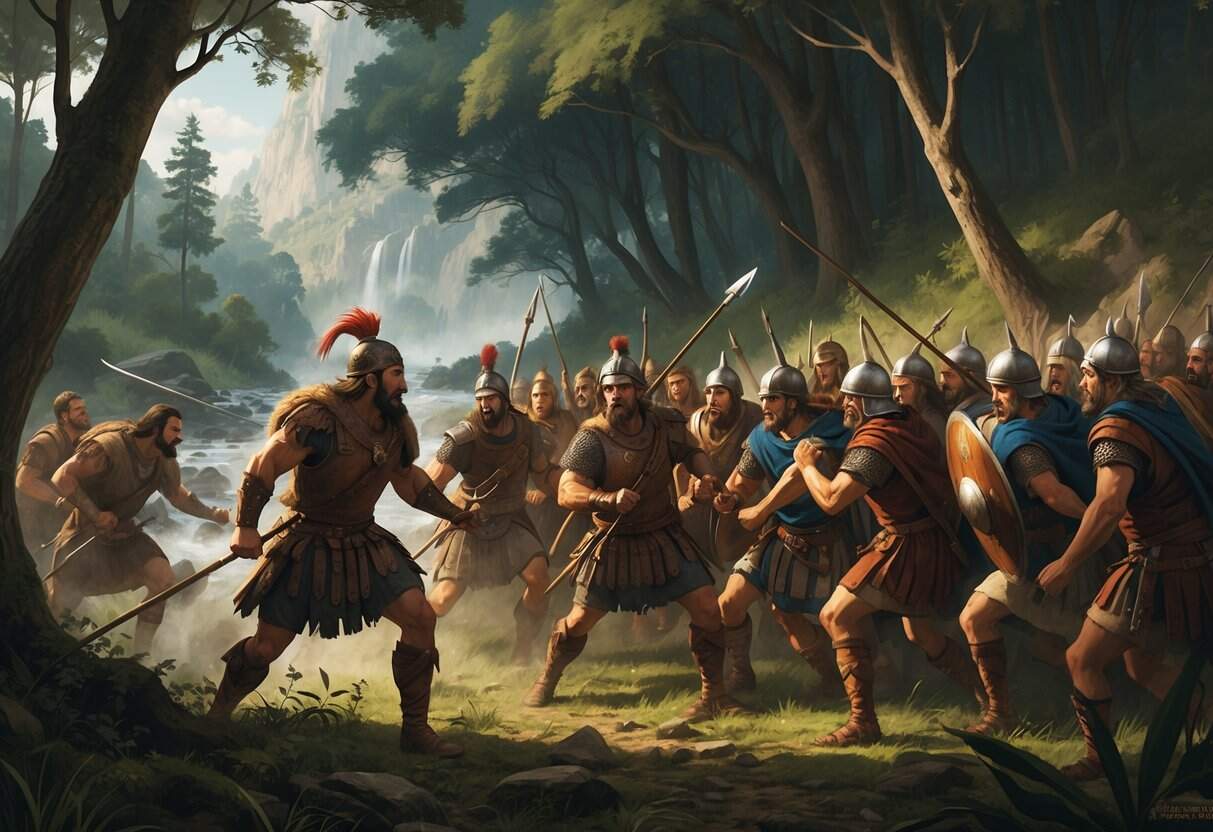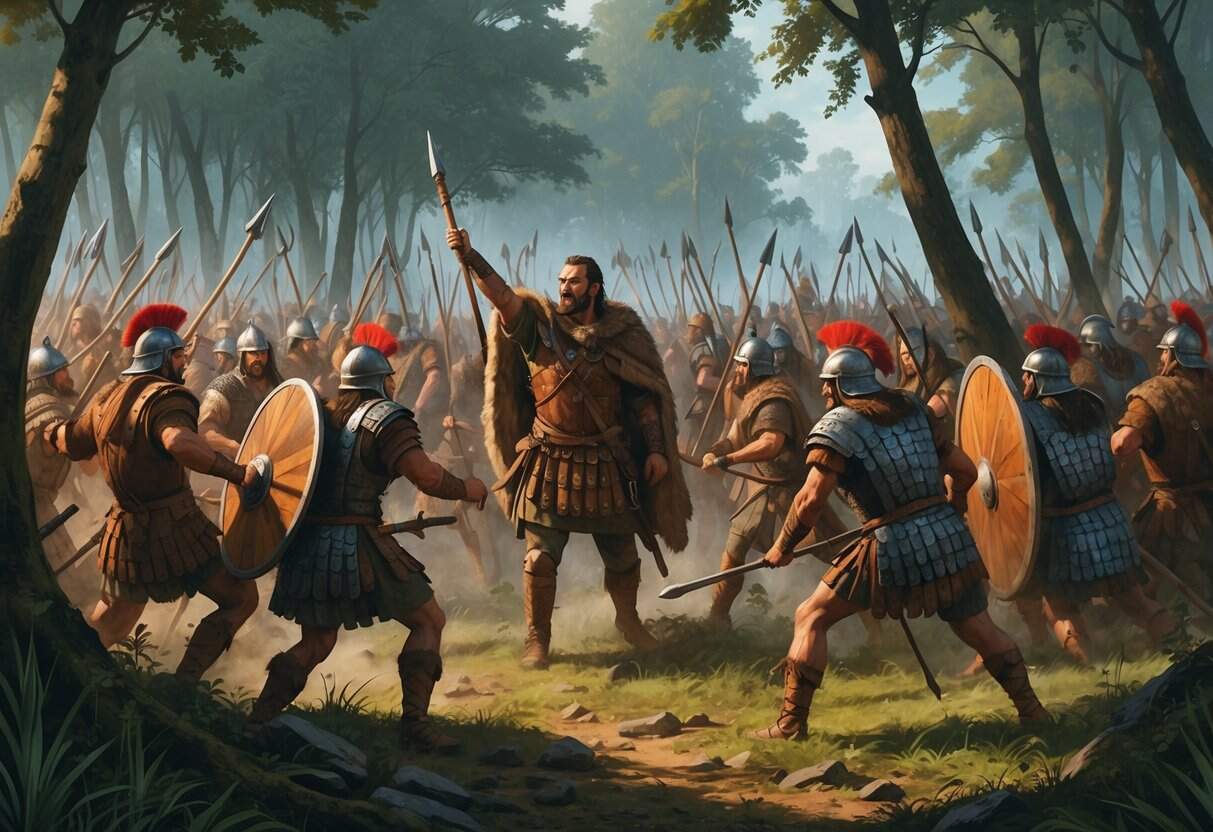Arminius managed to defeat the Romans in Germania by turning the thick forests to his advantage. He led the Germanic tribes into a brutal ambush at the Teutoburg Forest, where the Roman legions just couldn’t form up the way they were used to.
This surprise attack completely broke the Roman forces. It stopped them from grabbing control of the region for good.

Arminius really knew his stuff—he understood both Roman military tricks and the lay of the land. He used guerrilla tactics, hiding in the woods and setting traps that made it impossible for the Romans to fight back effectively.
The battle at Teutoburg Forest is a big reason Rome never managed to conquer Germania. It’s one of those moments in history where brains beat brute force.
Key Takeaways
- Arminius used the forest to set up a deadly ambush for the Roman legions.
- The Germanic tribes broke the Roman battle formations, which was a game-changer.
- Rome’s dream of expanding into Germania pretty much ended here.
Historical Background and Key Figures

There was a lot going on between Germania and Rome back then. The power struggles, the leaders, and the events that set up the famous battle all matter.
Digging into these details helps explain how Arminius pulled off such a wild victory.
The Political Landscape of Germania and the Roman Empire
In the early first century AD, the Roman Empire under Augustus was pushing to expand across the Rhine. Germania was a patchwork of independent tribes, each with their own leaders.
The Romans wanted new lands and resources, but the Germanic tribes weren’t exactly thrilled about giving up their freedom. The region was a mess politically—tribes fought each other and sometimes even sided with Rome if it suited them.
The Rhine River was the unofficial border. Rome’s push into Germania just stirred up more tribal tension.
The result? Local Germanic peoples and Roman military forces were constantly butting heads.
Arminius: From Roman Ally to Foe
Arminius led the Cherusci tribe. He’d actually spent part of his youth under Roman influence, even getting Roman citizenship and military training.
This gave him a unique edge—he saw how the Romans thought and fought.
At first, he played along as a Roman ally and soldier. But after witnessing how Rome treated his people and their land, he switched sides.
He secretly pulled together a coalition of Germanic tribes. His mix of Roman tactics and local knowledge made him a pretty terrifying opponent for the Romans.
Publius Quinctilius Varus and Roman Leadership
Publius Quinctilius Varus was the Roman general in charge of Germania. Augustus put a lot of trust in him to keep things under control and expand Roman power.
Varus led three Roman legions deep into Germanic territory. He didn’t realize just how much resistance he’d face, especially from Arminius.
Tacitus, the Roman historian, later wrote about Varus’s colossal failure. His mistakes and lack of awareness led to the total destruction of his legions in the Teutoburg Forest.
Origins and Preparations for the Teutoburg Forest Ambush
Let’s talk about what pushed Arminius to plan the ambush and how he managed to unite so many different tribes. Roman presence in Germania was a constant source of tension.
Arminius used his inside knowledge of Roman tactics to set up a devastating surprise attack.
Motivations Behind the Rebellion
Arminius wanted his people free from Roman rule. He saw Roman control as a direct threat to the independence of tribes like the Cherusci.
The Romans demanded taxes, forced tribes to supply soldiers, and took away local power. That didn’t sit well with anyone.
For Arminius, it was personal and political. He’d served Rome, but seeing what they did to his homeland changed everything.
His goal? Stop Rome’s expansion for good by crushing their forces.
Formation and Loyalty of the Germanic Tribes
Arminius managed to unite tribes like the Cherusci, Chatti, and Marsi. They all wanted to protect their land and culture from Rome.
Normally, these tribes did their own thing. But facing a common enemy, they agreed to work together—at least for now.
They knew the forests well and leaned into guerrilla tactics. Arminius built trust by showing real leadership and a knack for spotting Roman weaknesses.
Roman Expansion and Occupation in Germania
Rome tried to extend its empire by moving east of the Rhine, building forts, and leaving soldiers to keep the tribes in line. They wanted resources and control.
But they seriously underestimated how tough Germania was to hold. Roman soldiers were trained for open-field battles, not the tangled forests.
This left them wide open for ambushes—exactly what Arminius exploited.
The Battle of the Teutoburg Forest: Events and Aftermath
The ambush in the forest was meticulously planned. The destruction of three Roman legions under Varus changed everything for Rome’s ambitions in Germania.
The Ambush and Tactics Used in the Forest
Arminius knew Roman tactics inside out and used the landscape as his secret weapon. He lured Varus and his three legions into the Teutoburg Forest, where the narrow, muddy paths and thick trees made Roman formations useless.
Germanic warriors attacked in small, hidden groups. They’d hit hard, then vanish back into the trees.
Roman supply lines and communication got cut off. The Romans just couldn’t keep up, and the forest turned into a trap they couldn’t escape.
Key tactics:
- Ambushes in dense, unfamiliar forest
- Hit-and-run attacks that shattered Roman formations
- Blocking all possible escape routes
Defeat of the Roman Legions
Over four days, Arminius and his allies wiped out all three legions. The Romans couldn’t regroup or mount a real defense.
Heavy armor and big banners only made them easier to spot in the cramped woods. Roman standards—symbols of honor—were lost, which wasn’t just a military defeat but a huge blow to morale.
Varus’s men were killed or captured, and Varus himself ended his own life rather than face capture. The battle got called the Varian Disaster for good reason.
Aftermath and the Varian Disaster
Rome’s push into Germania stopped cold at the Rhine. Emperor Augustus was devastated by the loss.
He’s supposed to have cried out, “Quinctilius Varus, give me back my legions!” Rome never got those legions or their lost standards back.
Archaeologists have found weapons and coins near Kalkriese in modern Germany, which is believed to be the battle site. These finds help paint a picture of just how massive the defeat was.
Afterward, Rome fortified the Rhine border. They pretty much gave up on conquering Germania for decades.
Legacy and Impact on Roman and German History
Arminius’s victory left a permanent mark. Rome had to rethink its whole strategy in Germania.
His success became a symbol of German identity later on. The battle’s impact is still felt in how we talk about borders, military campaigns, and cultural memory.
Roman Responses and Campaigns After Teutoburg
After the disaster, Augustus was shaken. Rome stopped trying to expand east of the Rhine and focused on holding the line.
Tiberius and Germanicus tried to recover the lost legions and punish the tribes. Germanicus fought hard but couldn’t fully control the region.
Eventually, Rome decided the Rhine would be its boundary. That choice defined the edge of Roman rule in northern Europe.
Influence on Germania and the Birth of a Nation
Arminius managed to pull together tribes, even getting some reluctant allies like Segestes on board. His leadership gave the tribes a shared purpose—resist Rome.
The victory let Germanic culture develop on its own, east of the Rhine. There wasn’t a single “German nation” yet, but people see Arminius as the start of something bigger.
His legacy inspired later German nationalism. Even now, Arminius stands as a symbol of unity and resistance in German history.
Memory and Representation in Ancient and Modern Sources
Roman sources like Tacitus’s Annals give us detailed accounts, though you can feel the Roman bias in every line. They really zero in on Arminius’s betrayal—he’d served Rome, then flipped sides.
It’s clear these accounts shaped the Roman view of the defeat. For them, it was a shock and maybe even a warning.
Fast forward to modern times, and you’ve got historians and archaeologists like Major Tony Clunn digging up the actual site of the Battle of the Teutoburg Forest. That discovery sparked a fresh wave of interest.
Arminius stands out now as a major figure, not just in ancient history but in German cultural memory too. His story somehow bridges the ancient world and today.
| Aspect | Details |
|---|---|
| Roman Leaders | Augustus, Tiberius, Germanicus |
| Key Germanic Figures | Arminius, Segestes |
| Roman Sources | Tacitus’s Annals |
| Battle Location | Teutoburg Forest |
| Impact on Borders | Rhine River as Roman frontier |